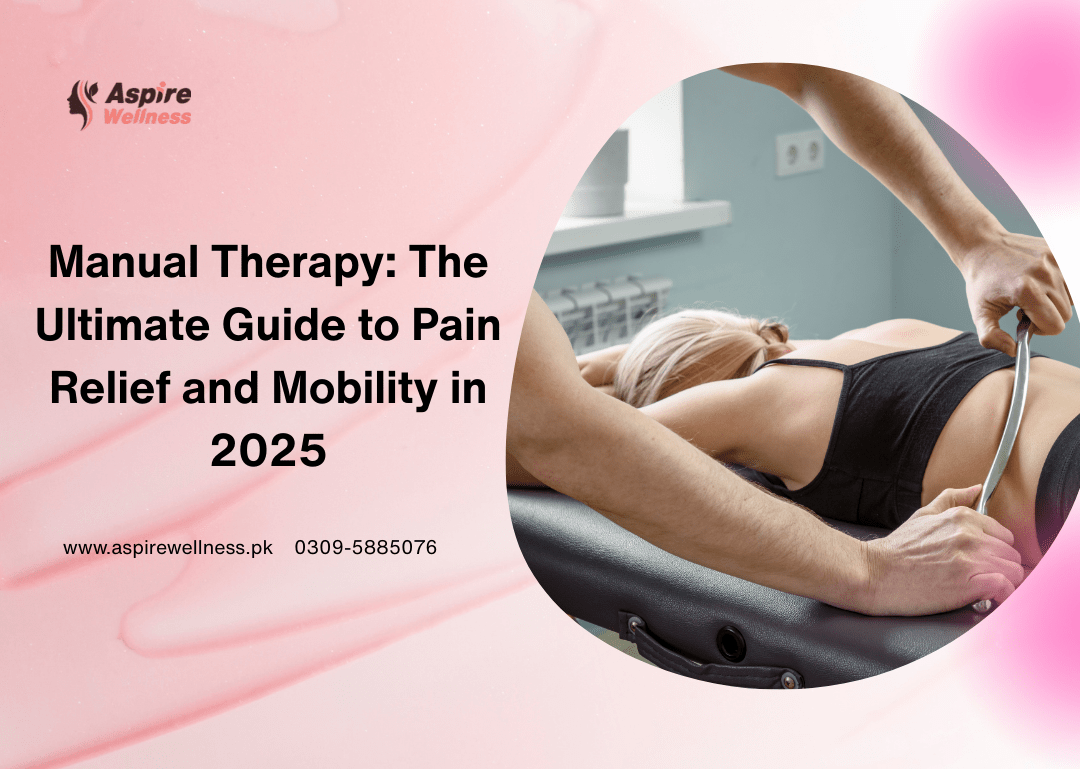When people hear the term manual therapy, many instantly picture a relaxing massage or spa session. But let’s set the record straight—manual therapy is not just about feeling good; it’s about getting better.
Unlike a typical massage, it is a hands-on clinical treatment used by physiotherapists to diagnose, treat, and correct issues like joint dysfunction, muscle tightness, and mobility limitations.
Whether you’re struggling with chronic back pain, recovering from an injury, or dealing with a frozen shoulder, physiotherapy goes beyond surface-level relief. It targets the root cause of your pain and restores proper movement using precise, therapist-guided techniques.
Let’s dive into what makes it different—and why it’s gaining attention in 2025.
Section 1: What Is Manual Therapy and How Is It Different?
It is a specialized branch of physiotherapy where clinicians use their hands—not machines or devices—to assess and treat musculoskeletal pain, stiffness, or dysfunction. It’s commonly used for patients who suffer from:
Unlike modalities like hot packs or ultrasound, manual therapy offers real-time feedback, allowing therapists to adapt treatment on the spot. That’s what makes it so effective—it’s not one-size-fits-all. Every movement, pressure point, and technique is personalized to meet your specific needs.
🤲 Hands-On Treatment with a Purpose
Manual therapy in physiotherapy is purposeful and results-driven. It doesn’t just focus on symptom relief; it aims to restore function and prevent future problems. Whether you’re dealing with an old sports injury or nagging neck pain from desk work, it is tailored to bring your body back into balance.
Here’s what separates manual therapy from other forms of physical treatment:
-
Precise, therapist-guided techniques
-
Assessment + treatment in real time
-
Immediate improvement in joint and muscle performance
-
Targets the cause, not just the symptoms
So, if you’ve been stuck in a cycle of painkillers and temporary relief, manual rehab therapy might be the long-term solution you’ve been looking for.
Section 2: Manual Therapy Techniques That Actually Work
One of the best things about it is the wide range of techniques available. These are not random movements—they’re evidence-based methods designed to relieve pain, restore function, and support recovery.
Let’s explore the most powerful and widely-used manual therapy techniques in physiotherapy today:
🔹 Joint Mobilization
This involves gentle, passive movements of stiff joints. It’s especially useful for:
By improving joint play and flexibility, mobilization reduces pain and enhances range of motion.
🔹 Soft Tissue Manipulation
Think of this as a deep-tissue reset. The therapist targets tight muscles, fascia, and tendons to:
-
Reduce inflammation
-
Improve circulation
-
Break down scar tissue
This technique is often used for back pain, shoulder injuries, and neck tension.
🔹 Myofascial Release
Fascia is the thin connective tissue that surrounds your muscles. When it tightens or sticks, it can restrict movement and cause pain. Myofascial release uses sustained pressure to release those restrictions, perfect for people with:
-
Chronic pain syndromes
-
Limited flexibility
-
Movement dysfunction
🔹 Trigger Point Therapy
These are the “knots” you often feel in your muscles that radiate pain elsewhere. A therapist will locate and apply pressure to these trigger points to release them. This is especially helpful for:
🔹 Passive Range of Motion (PROM)
Used when a patient can’t move a joint on their own—common in post-surgical rehab. The therapist gently moves the joint to:
🔹 Deep Tissue Techniques
Going deeper into the muscle layers, this manual technique targets long-standing pain and stiffness. Ideal for:
Why These Techniques Matter
Each of these methods serves a specific purpose, and in most treatment plans, your physiotherapist will combine them based on your condition. The ultimate goal? Pain relief, improved mobility, and a faster, drug-free recovery.
So whether you’re Googling manual therapy near me or just starting your recovery journey, knowing these techniques helps you understand the process—and the incredible results they can deliver.
Section 3: Who Can Benefit from Manual Therapy?
You don’t have to be an athlete or someone recovering from surgery to benefit from manual therapy. One of the biggest misconceptions is that it’s only for serious injuries or high-level rehab. In reality, it is for anyone dealing with musculoskeletal pain, stiffness, or mobility issues.
Here’s a closer look at who can benefit the most from manual therapy in physiotherapy:
✅ Office Workers with Poor Posture
Sitting all day can lead to hunched shoulders, tight hip flexors, and chronic neck pain. therapy for posture correction focuses on releasing tension in overused muscles and realigning the body to its natural state.
✅ People Suffering from Chronic Pain
If you’ve been battling chronic back pain, neck stiffness, or joint pain that doesn’t seem to go away, it offers a non-invasive solution. Techniques like joint mobilization and soft tissue therapy provide pain relief and long-term results—without relying on medications.
✅ Post-Surgical Patients
Recovering from a knee replacement, rotator cuff repair, or spinal surgery? it helps restore mobility, prevent scar tissue build-up, and accelerate recovery. Manual therapy post-surgery is often the first step in a comprehensive rehab plan.
✅ Seniors Looking to Stay Active
As we age, we lose flexibility and joint mobility. therapy for seniors can ease stiffness, improve balance, and reduce the risk of falls by restoring natural movement patterns.
✅ Athletes and Sports Enthusiasts
Athletes use manual therapy for injury prevention and faster recovery. Whether it’s tennis elbow, runner’s knee, or rotator cuff strain, hands-on therapy helps reduce inflammation, release tight muscles, and support functional movement.
✅ People with Sciatica or Nerve Pain
for sciatica involves techniques that release the piriformis muscle and reduce pressure on the sciatic nerve. It’s a safer, more sustainable alternative to corticosteroid injections or surgery.
Section 4: Top Benefits of Manual Therapy for Pain Relief and Mobility
it isn’t just about relieving pain—it’s about getting your life back. Whether you’re an athlete, a desk worker, or recovering from an accident, the benefits of manual therapy techniques go far beyond temporary relief.
1. 🔓 Immediate Pain Relief
Many patients feel better right after the first session. Techniques like trigger point therapy and joint mobilization can reduce pain in areas like:
-
Lower back
-
Neck and shoulders
-
Hips and knees
-
Post-operative joints
2. 🦴 Improved Joint Mobility
Stiff joints don’t just hurt—they limit how you move. Manual therapy for joint stiffness helps restore natural motion, allowing you to move without restrictions.
3. 💪 Restored Muscle Function
Muscles can become weak, tight, or imbalanced due to injury or inactivity. Soft tissue manipulation improves blood flow, reduces tension, and helps muscles perform better.
4. 🔍 Addresses the Root Cause
Instead of masking pain like painkillers do, manual rehab therapy targets the actual source of dysfunction. Whether it’s a stuck joint, inflamed tissue, or poor alignment, manual therapy fixes what’s actually wrong.
5. 🧘 Enhances Overall Wellbeing
It improves body mechanics, posture, and coordination. You’ll not only move better but feel better—mentally and physically.
6. 🏃 Accelerates Healing After Injury
When you combine manual therapy with physiotherapy exercises, your body recovers faster. It helps reduce swelling, improve circulation, and prepare your muscles and joints for movement again.
Real Talk: Why Manual Therapy Works
It’s not magic—it’s movement science. therapy techniques are rooted in biomechanics and clinical evidence. By restoring proper joint alignment and releasing soft tissue restrictions, you’re literally freeing your body to heal.
Section 5: How Manual Therapy Complements Other Physiotherapy Techniques
Here’s the secret sauce: manual therapy isn’t a standalone miracle—it shines brightest when combined with other physiotherapy treatments.
Imagine this: your joints are stiff, your muscles are tight, and your posture is off. Jumping straight into strength exercises without first correcting those imbalances is like building a house on a crooked foundation.
That’s where manual therapy in physiotherapy takes the lead.
🔗 Manual Therapy + Therapeutic Exercises = Faster Recovery
Manual therapy prepares your body by relieving pain and improving range of motion. Once you can move better, your physiotherapist introduces corrective exercises for:
It’s a one-two punch that makes your treatment more effective.
🧊 Manual Therapy + Modalities (e.g., Ice/Heat, TENS)
In some cases, tools like electrical stimulation or hot/cold therapy can be used before or after manual therapy to enhance results. But the hands-on work is where the real magic happens—it addresses the underlying cause.
🧘 Manual Therapy + Postural Re-education
If poor posture is behind your chronic pain, your physiotherapist may integrate postural training with manual techniques to help you sit, stand, and move better in your daily life.
🧠 Manual Therapy + Patient Education
Let’s not forget this crucial part. Educating you about your condition, movement patterns, and proper ergonomics turns short-term relief into long-term recovery.
Whether you’re recovering from surgery or managing a chronic issue like arthritis, combining manual therapy with a full physiotherapy program leads to faster, longer-lasting results.
Section 6: How to Choose the Right Manual Therapy Provider Near You
If you’re Googling “manual therapy near me” or trying to find a trusted physiotherapy clinic, here’s what you should be looking for—not just someone with good marketing, but a clinic that genuinely delivers results.
🧑⚕️ 1. Look for Licensed Physiotherapists
Manual therapy should only be performed by certified professionals trained in anatomy, biomechanics, and hands-on treatment techniques. Make sure the clinic clearly states their credentials.
📋 2. Ask About Personalized Treatment Plans
No two bodies are the same, so why settle for a cookie-cutter approach? The best manual therapy clinics provide individualized plans based on:
-
Your diagnosis
-
Functional limitations
-
Recovery goals
💬 3. Check Patient Testimonials and Reviews
What are others saying about the clinic? Look for reviews that mention manual therapy results, such as pain relief, faster healing, and improved mobility.
🎯 4. Inquire About Experience with Your Condition
Whether it’s manual therapy for back pain, post-surgery recovery, or neck stiffness, your therapist should be familiar with treating your specific issue.
🔎 5. Transparency and Education
A great provider will walk you through the process, explain what to expect, and involve you in your recovery journey. You should feel heard, informed, and empowered—not confused.
🏁 Bonus Tips for Finding the Best Manual Therapy Near You:
-
Search for “best manual therapy clinic in [your city]”
-
Look for a physiotherapist who offers both manual and exercise-based rehab
-
Check if the clinic specializes in your condition (e.g., sports injuries, sciatica, post-operative care)
Section 7: Manual Therapy – Frequently Asked Questions (FAQs)
❓ Is manual therapy painful?
No, manual therapy should not be painful. Some techniques may cause mild discomfort, especially if you’re dealing with chronic muscle tightness or joint stiffness. However, a skilled manual therapy physiotherapist will always adjust the pressure based on your comfort level.
❓ How many sessions of manual therapy do I need?
It depends on your condition. For acute injuries, you may feel relief in just a few sessions. For chronic pain or post-operative rehab, your therapist may recommend a longer treatment plan that combines manual therapy techniques with targeted exercises.
❓ Is manual therapy safe for everyone?
Generally, yes. However, those with conditions like osteoporosis, fractures, or certain inflammatory diseases should consult a physiotherapist for a tailored approach. That’s why it’s crucial to seek professional manual therapy from licensed experts.
❓ Can I do manual therapy at home?
While some stretches and self-massage tools help, true clinical manual therapy must be performed by a trained physiotherapist. They can assess the root cause and apply the correct hands-on techniques for lasting results.
❓ What should I expect after a manual therapy session?
You may feel:
-
Immediate relief or increased range of motion
-
Mild soreness (like post-workout)
-
Better movement in daily activities
Always follow your therapist’s advice on post-treatment care, like staying hydrated or doing gentle stretches.
Section 8: Final Thoughts – Is Manual Therapy Worth It?
Let’s cut through the noise: manual therapy isn’t just a trend—it’s a proven, evidence-based approach that treats pain at its source. Whether you’re an athlete with a sports injury, an office worker with neck pain, or someone recovering from surgery, manual therapy offers a non-invasive, drug-free path to healing.
And in 2025, as more people search for natural and personalized recovery options, manual therapy in physiotherapy is becoming the gold standard.
It’s not about a quick fix. It’s about:
✔ Relieving pain
✔ Restoring movement
✔ Reclaiming your lifestyle
So, if you’re tired of masking symptoms and want real, lasting results—manual therapy might be exactly what your body needs.
💬 Ready to Experience Manual Therapy?
Don’t let pain hold you back any longer.
👉 Book a consultation with a certified physiotherapist near you and discover the power of manual therapy for pain relief and mobility.
Whether you’re searching for manual therapy near me, looking to recover from injury, or just want to move better—now is the time to take action.
Your body will thank you.



